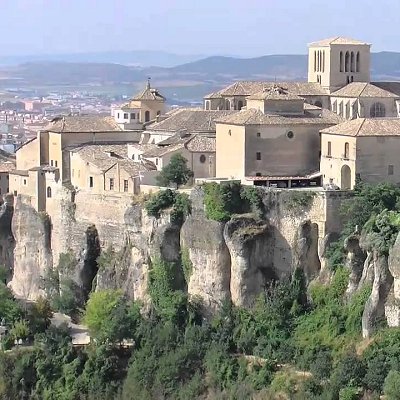
Like us on Facebook
PLACE NAMES




|
|
Cuenca
|

|
|
Cuenca is a city in the autonomous community of Castile-La Mancha in central Spain. It is the capital of the province of Cuenca.
Its name may derive from the Latin conca meaning "river basin", referring to the gorge of the rivers Jucar and Huécar. It may also be derived from the now-ruined Arab castle, Kunka. Other alternative original names have been suggested, including "Anitorgis", "Sucro" or "Concava". The city of Cuenca is also known as the "Eagle's Nest" because of its precarious position on the edge of a gorge.
Main sights include:
- Cathedral of Our Lady of Grace and Saint Julian Cuenca Cathedral was built from 1182 to 1270. The façade was rebuilt after it crumbled down in 1902. It is the first gothic style Cathedral in Spain (together with Avila's one), because of the influence of Alfonso VIII's wife, Eleanor, daughter of King Henry II of England and his wife, Eleanor of Aquitaine, who introduced the Anglo-Norman style. From that date the cathedral has undergone some changes. An apse-aisle (doble girola) was added in the 15th century, while the Renaissance Esteban Jamete's Arch was erected in the 16th century. The main altar was redesigned during the 18th century by famous architect Ventura Rodríguez: it features a precious iron-work gate. The façade was rebuilt in 1902 from ruins due to the collapse of the former bell tower, the Giraldo. In the early 1990s modern coloured windows were installed, and in 2006 one of the two old baroque organs from Julián de la Orden was recovered. The other organ has also been restored, and on 4 April 2009 an inauguration ceremony was held. The naves do not follow exactly a straight line. The San Julián altar, dedicated to Saint Julian of Cuenca, at the apse-aisle, consists of columns made of green marble. Another curiosity are the "Unum ex septem" signs at some chapels. It is said that if one prays looking at these signs one would obtain a five-year forgiveness for one's sins, and seven years if one prays during the patron saint's day.
- Church of Saint Peter With Romanesque origins, the church of St. Peter (San Pedro in Spanish) was rebuilt by Jose Martin de la Aldehuela during the 18th century and displays since that time a Baroque façade. It shows an octagonal shape outdoors but it is circular inside, and it is located at Plaza del Trabuco. This church can be reached by going up along San Pedro Street from Plaza Mayor.
- Church of Saint Michael was erected during the 13th Century, with only one nave and an apse. In the 15th Century, a second nave at the north side was added. The dome was built by Esteban Jamete in the 16th Century, and finally the wooden ceiling of the two naves was replaced with stone vaults during the 18th Century. Saint Michael was restored in the 20th Century, and its management was transferred to Cuenca's municipality from Cuenca's Diocese, so that this church could be used to hold classical music concerts. In fact, Saint Michael is home of the Religious Music Week (Semana de Musica Religiosa) together with other places within the city and its province. It is located at San Miguel street, next to Plaza Mayor. Saint Michael is accessed through a descending narrow passage which starts at Plaza Mayor left lateral (looking from the Town Hall).
- Church of Our Savior (Iglesia del Salvador) Built in Neo-Gothic style during the 18th century, with only one nave and a high tower. It shows a modest baroque façade and some remarkable baroque altars indoors. The door is however quiet modern, added in the late 1990s. The famous religious procession "Las Turbas", held on Good Friday morning, starts at this location, since the image of "Jesus el Nazareno", which is at the forefront of the procession, is kept within "El Salvador".
- The bridge of Saint Paul (Puente de San Pablo) was built from 1533 to 1589, a construction driven by the canon Juan del Pozo, over the gorge of the River Huecar, aiming at connecting the old town with St Paul convent. The original bridge collapsed, and the current one was built in 1902, made of wood and iron according to the style dominating at the beginning of the 20th century. It is up to 40 metres high and supported by the remains of the old bridge.
- The Seminary (Seminario), a rectangular building stretching from Plaza de la Merced to Mangana Square, was established under the rule of José Flores y Osorio, the Bishop of Cuenca (1738-1759), and built by Vicente Sevill, around 1745. The Baroque façade at Plaza de la Merced was erected in 1748. It holds a library with numerous ancient books, some of them "incunables" (previous to 1501). There is also a Rococo meeting room inside and a Gothic altarpiece at the chapel, but visits are not allowed. In 2004 some books from this library were stolen, but the suspect of the robbery was caught and the books recovered before entering on an auction process. Now an average of 10-15 future priests are trained there, according to statistics of the Spanish Episcopal Conference.
- The convent of Saint Paul was built in the 16th century by command of the canon priest Juan del Pozo, a monk belonging to the Dominican Order. Brothers Juan and Pedro de Alviz were in charge of the building project; Pedro worked on the convent and the cloister and Juan on the church. The church was finished in the 18th century, in rococo style. The convent was ruled by Dominican friars, but during the 19th century was handed over to the Pauline Fathers, who were based here until 1975, when they left due to the possible collapse of the building. In the 1990s the convent was restored to house the Parador Nacional de Turismo in Cuenca, a hotel which allows the visit to the convent as well as the access to the church. The cloister has an ornamental source of water, and the cafeteria is the old chapel. From the convent the old town can be reached easily by crossing St Paul bridge.
- The bishop's palace features, on three of its museums, the Diocese's Museum, which has a remarkable collection of religious art. It can be easily accessed from the cathedral. The rooms where the collection is shown were remodeled by architect Fernando Barja Noguerol, and Gustavo Torner selected the art pieces from an inventory made by some priests of the Diocese in 1977. Some of the diocese's artistic patrimony was lost during the Peninsular War, the confiscation of ecclesiastical property by Juan Álvarez Mendizábal, and the Spanish Civil War. Masterpieces like The Byzantine Diptych (book-like silver work whose origin is dated around 1370, containing saints' relics), paintings by El Greco, and handcrafted carpets from Cuenca's school, can be seen at the museum.
- El Castillo is the name for the remains of an ancient Arab fortress, representing the older structures of Cuenca. Only a tower, two stone blocks, the arch which allows to enter/leave the old town from the Barrio del Castillo and a fragment of the walls have been left. The arch (arco de Bezudo) is named after Gutierre Rodriguez Bezudo, from Segovia, who fought the Arabs with King Alfonso VIII to conquer Cuenca. The castle was home of the Holy Inquisition after 1583, and it was finally destroyed during the 19th century by French soldiers during the Spanish War of Independence. Nearby are the small chapel and cemetery of San Isidro.
- Mangana Tower The origins of the Mangana Tower remain unclear. In 1565 it was painted by Anton van den Wyngaerde, which indicates that at that time Mangana had already been built up, and after the attacks by French soldiers during the Spanish War of Independence war - at the beginning of the 19th century - and having been hit previously by a thunderbolt in the 18th century, it became badly destroyed. Mangana Tower was rebuilt by Fernando Alcántara in Neomudejar style - inspired on Arab decorative motifs - in 1926. Finally Victor Caballero gave Mangana its current look in a fortress-like style in 1968. It has a clock on one of its walls and a recording of bell chimes can be heard in the old town at certain times (every quarter of an hour). There are views from the near viewpoints over the river Jucar's gorge and the modern neighborhoods. Mangana can be reached on foot from Plaza Mayor.
- The Town Hall is a building in baroque style built up during the ruling period of King Carlos III and supported over three Roman arches. It was finished in 1762, as it can be read on the façade. The central arch is the only one giving access to vehicles to Plaza Mayor.
- Hanging Houses Built over a rock above the Huecar River gorge in the 15th century, Las Casas Colgadas are the only remaining samples of this type of building which was common in this city a long time ago. Hanging Houses can be considered the most famous civil buildings in Cuenca. They house a restaurant and the Museum of Abstract Arts and they serve as the background of millions of photos made from the bridge of San Pablo.
- Monument devoted to the Sacred Heart of Jesus On top of the Cerro del Socorro you can find the monument devoted to the Holy Heart of Jesus, whose materials were transported on donkeys in the mid-20th century. This place is a magnificent viewpoint over the city. It can be accessed by taking the road to Palomera / Buenache de la Sierra (Huecar river gorge) and turn right after 5 km (3 mi), approx.
- Cuenca Province Council The provincial council's seat (Diputación provincial de Cuenca) is a building with 2 floors built at the early 20th century according to a project conceived by provincial architect Rafael Alfaro. Cuenca's coat of arms at the façade is made of Carrara marble.
- Other notable buildings in Cuenca include the San Felipe Neri church, the Our Lady of Light church (Iglesia de Nuestra Señora de La Luz) and the Las Petras convent.
Museums
- Archeological Museum which contains items from the Archaeological Park of Segóbriga
- Diocese's Museum
- Museum of Spanish Abstract Art
- Museum of Science of Castile-La Mancha
- Holy Week Museum of Cuenca
- Fundación Antonio Pérez
- Fundación Antonio Saura
 Feel free to Email me any additions or corrections Feel free to Email me any additions or corrections
LINKS AVAILABLE TO YOUR SITE
| | |





